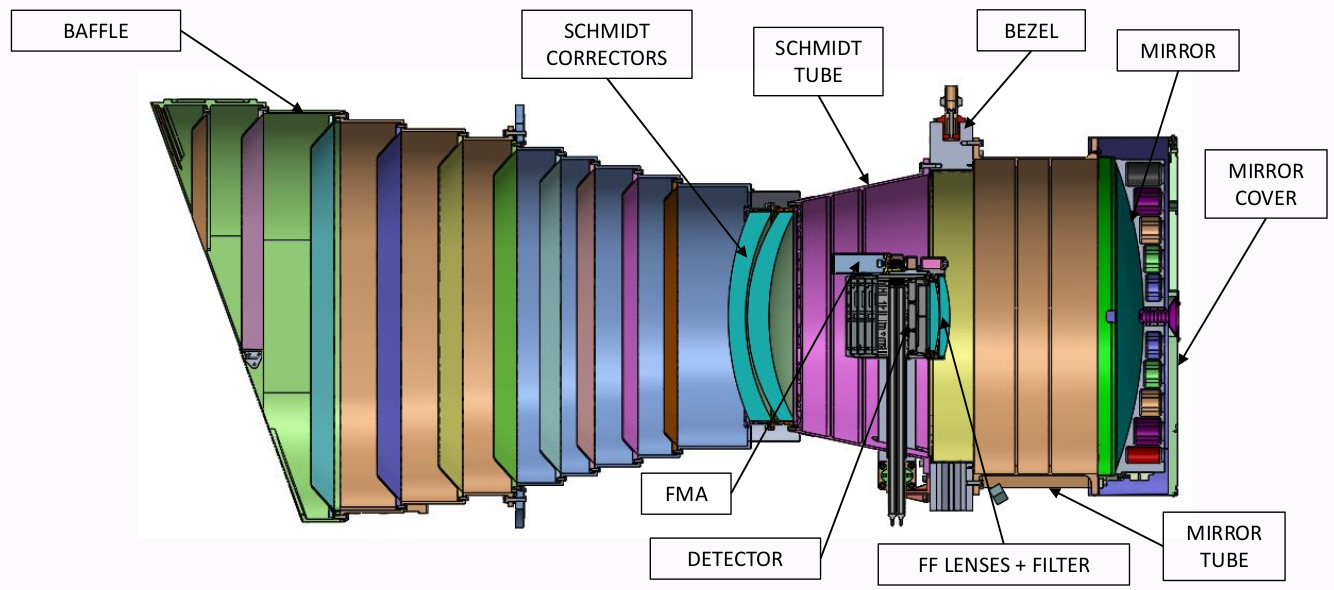ULTRASAT achieves its wide-field capabilities via a wide-field Schmidt telescope. A 33-cm diameter double corrector plate, made of a single fused silica lens and a single CaF2 lens, is mounted at the entrance of the telescope. The 50 cm diameter Zerodur mirror has a clear aperture of 48 cm. A field-flattener assembly, made of a fused silica lens, a CaF2 lens and a Sapphire filter, is mounted ~500mm in front of the focal plane array.
Attenuation of signals in wavelengths outside the operation band while maintaining high throughput within the operation band is of utmost importance for achieving the required S/N. Background sources include zodiacal light as well as light from the host galaxy of the transient. The payload design addresses the out-of-band attenuation by minimizing the “red leak” with a combination of tested coatings on the sapphire filter, lenses, mirror, and the detector. This leads to 3x10−5 (band average) rejection ratio while maintaining >25% in-band total throughput (see Figure 3.2). The high UV QE of the detector shown in Figure 4.2 is achieved by a NUV-optimized high-K dielectric and custom anti-reflection coatings.
ULTRAST archives its high grasp via a novel optical design, with a chromatic radial-dependent PSF optimized to the ULTRASAT band. The system area-averaged PSF FWHM (including spacecraft jitter, thermal variations and assembly errors) is better than 9’’, meeting the science specifications.
A 20o slanted baffle is mounted in front of the telescope to prevent stray light from entering the telescope and to reduce Cerenkov radiation. The slanted geometry allows the telescope to point >70o from the Sun without allowing any Sunlight to enter the optical system baffle. The baffle includes vanes to suppress the stray light from Earth and moon which, together with the telescope elements (in particular the Sapphire filter and the mirror), achieve <2x10-11 stray light suppression. The second main task of the baffle is to reduce by ~1/10 the background Cerenkov radiation, which is one of the main noise sources.

Figure 3.1: The Wide field UV telescope

Figure 3.2. ULTRASAT total throughput - including all optical throughput, detector QE (see Camera page), and obscuration.
| Property | Value | Comments |
|---|---|---|
| Aperture | 33 cm | |
| Focal length | 36 cm | |
| Field of View | 204 deg2 | Covered by 4 dies |
| Pixel scale | 5.4"/pix | |
| Operation waveband | 230-290 nm | Operation waveband |
| Total throughput in operation waveband | 0.25 | |
| Out-of-Band Rejection (> 300 nm) | 3x 10−5 | |
| Obscuration | 0.35-0.42 | From center FOV to detector edge |
| Mean effective PSF | 8.3’’ | In central 170 deg2 of FoV For T = 20,000 K blackbody source. |
| Earth stray-light suppression | <2x10-11 |
